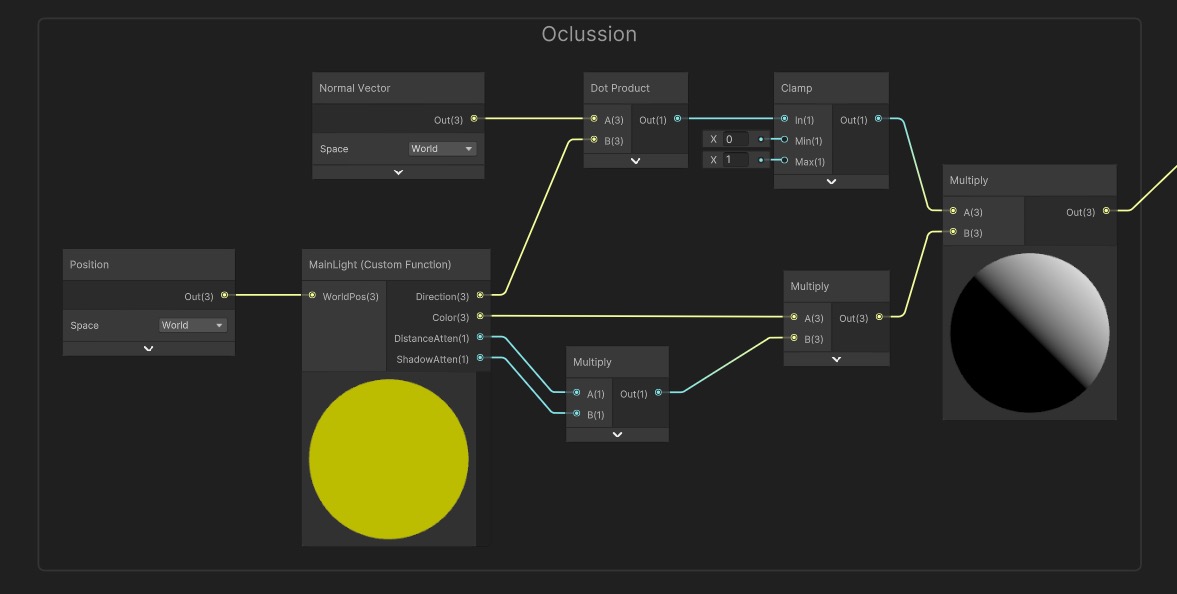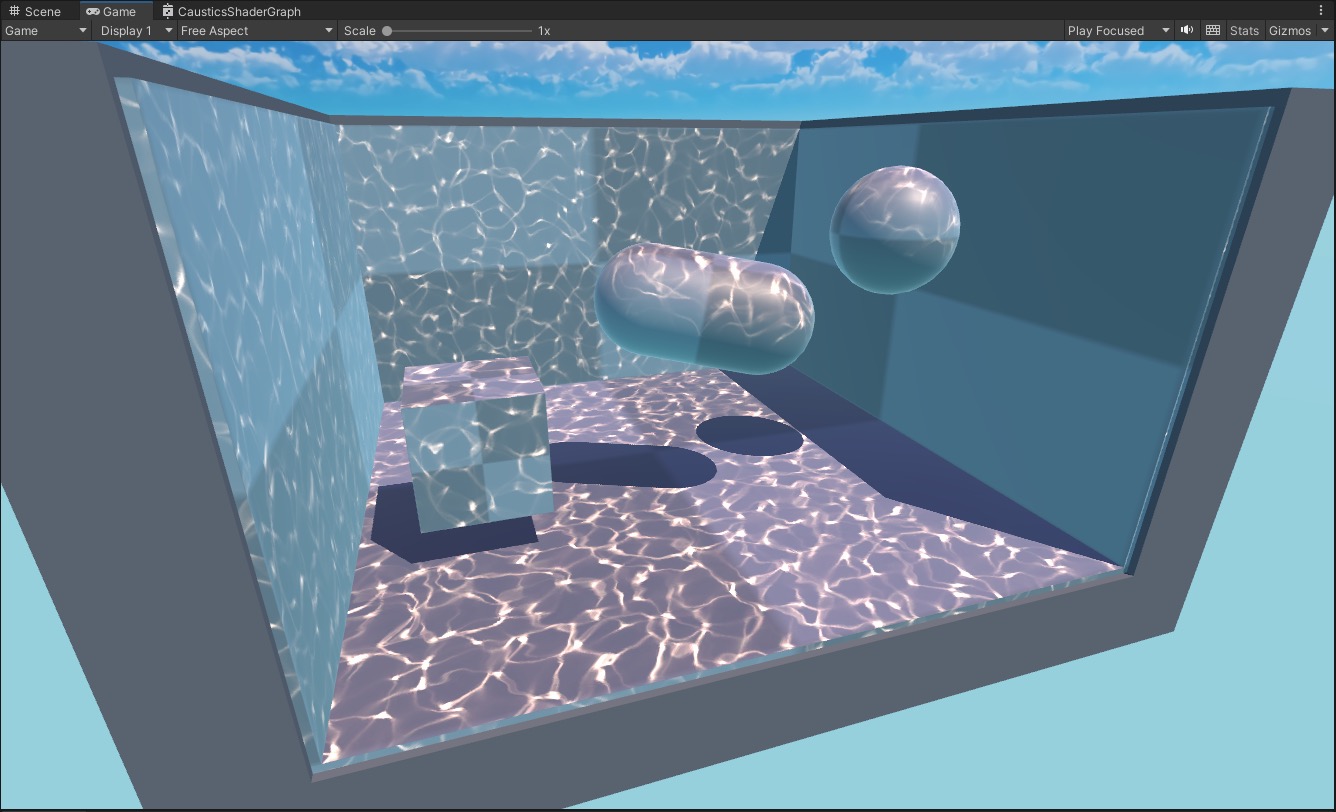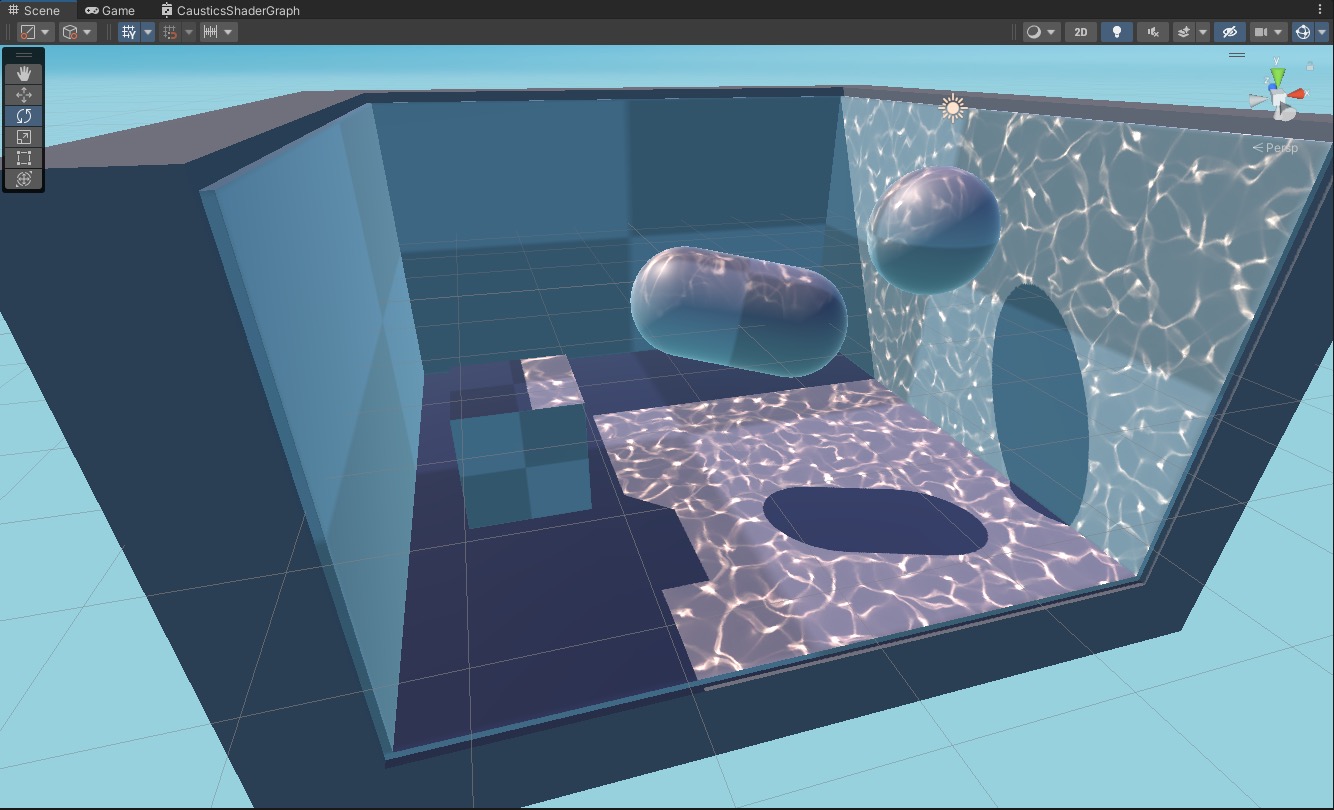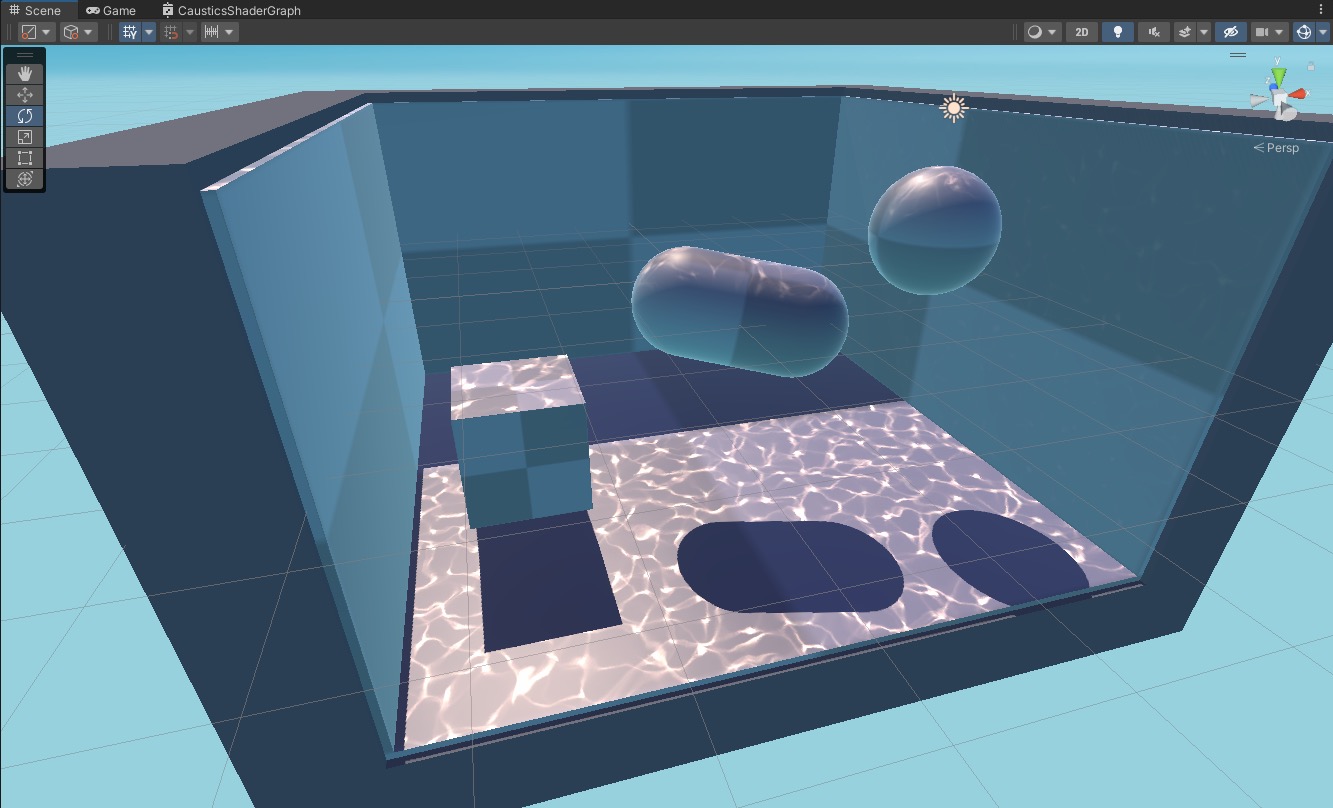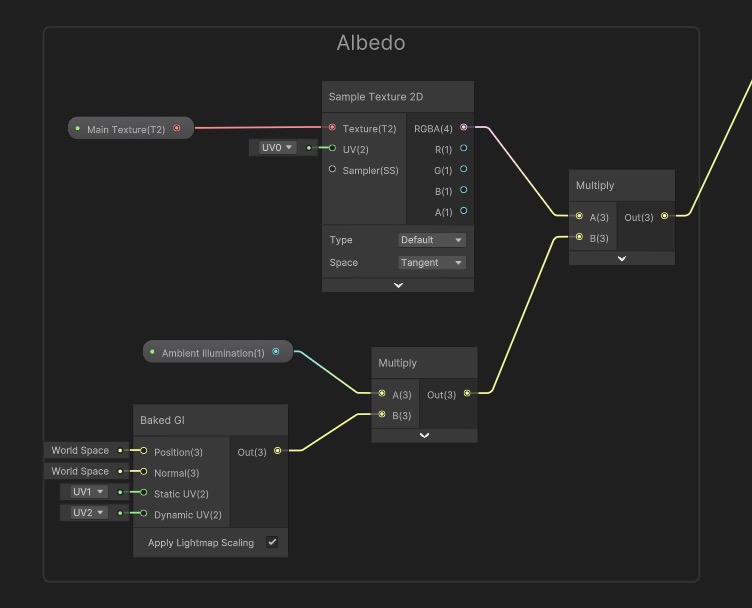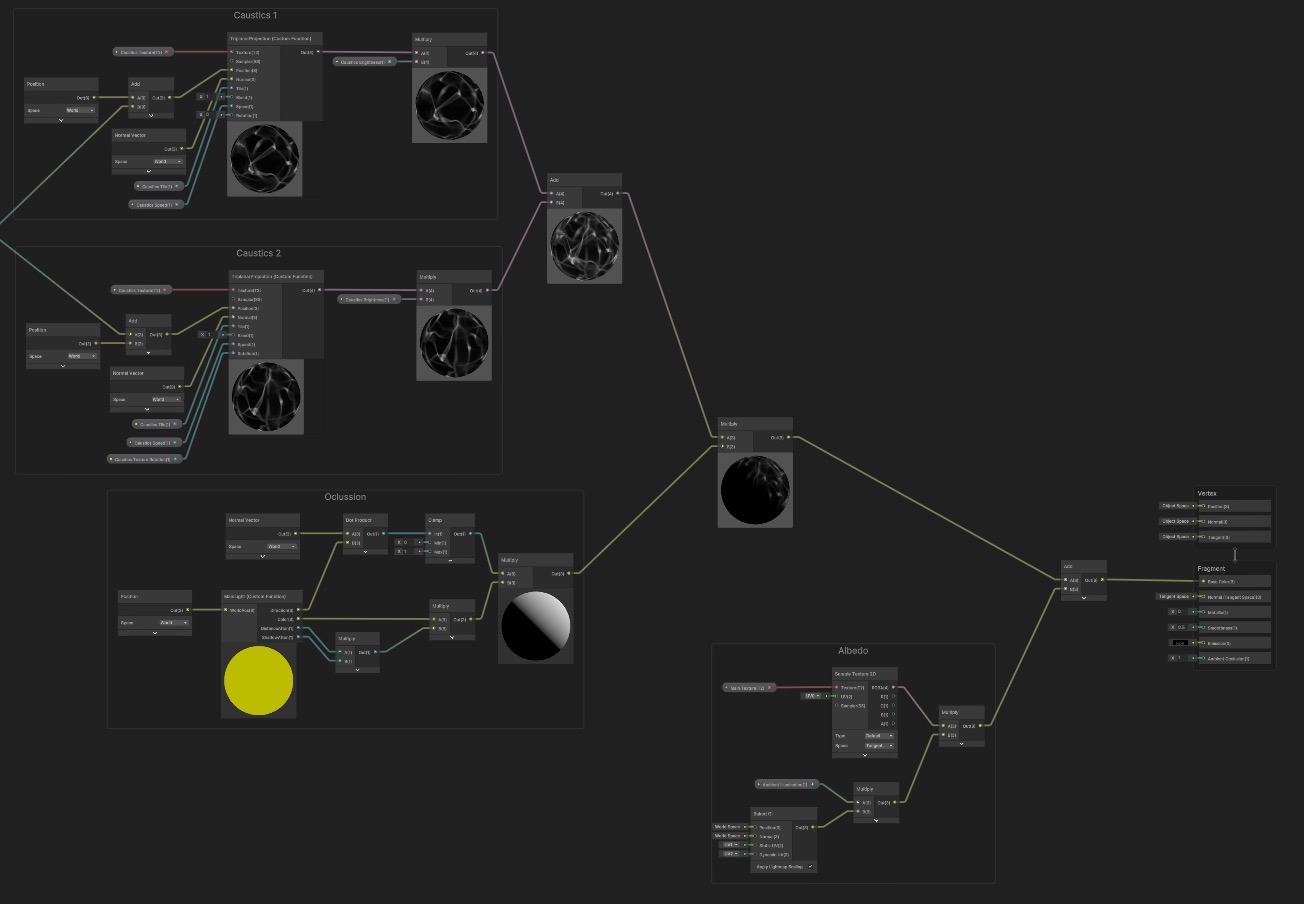Water Caustics Shader implemented with Shader Graph in Unity 2021.3.10f1
7.mp4
- Jettelly Caustics Tutorial 1
- Jettelly Caustics Tutorial 2
- Caustics Texture
- Stylized Skybox
- Custom Lighting in Shader Graph
- Triplanar ShaderGraph Node HLSL code
- UV Rotation ShaderGraph Node HLSL code
- Built a basic pool and put some primitive objects inside.
- Used the stlylized skybox to make the scene look more polished.
- Based on the example for implementing custom lighting in Shader Graph, we define the custom HLSL function to get the main light.
SHADERGRAPH_PREVIEWwill be true while developing the shader in the Shader Graph node editor.
void MainLight_half(
in float3 WorldPos,
out half3 Direction,
out half3 Color,
out half DistanceAtten,
out half ShadowAtten
)
{
#if SHADERGRAPH_PREVIEW
Direction = half3(0.5, 0.5, 0);
Color = 1;
DistanceAtten = 1;
ShadowAtten = 1;
#else
#if SHADOWS_SCREEN
half4 clipPos = TransformWorldToHClip(WorldPos);
half4 shadowCoord = ComputeScreenPos(clipPos);
#else
half4 shadowCoord = TransformWorldToShadowCoord(WorldPos);
#endif
Light mainLight = GetMainLight(shadowCoord);
Direction = mainLight.direction;
Color = mainLight.color;
DistanceAtten = mainLight.distanceAttenuation;
ShadowAtten = mainLight.shadowAttenuation;
#endif
}- Simply a copy paste of the HLSL code from the documentation for the Shader Graph Node to do UV roation.
float2 Unity_Rotate_Degrees_float(float2 UV, float2 Center, float Rotation)
{
Rotation = Rotation * (3.1415926f/180.0f);
UV -= Center;
float s = sin(Rotation);
float c = cos(Rotation);
float2x2 rMatrix = float2x2(c, -s, s, c);
rMatrix *= 0.5;
rMatrix += 0.5;
rMatrix = rMatrix * 2 - 1;
UV.xy = mul(UV.xy, rMatrix);
UV += Center;
return UV;
}- Based on the HLSL code from the Shader Graph Node to do Triplanar Projection.
- The modifications for this include passing in a Speed and Rotation for the UVs.
- The offset will be calculated with Time and Speed.
- The rotation will be used with the previously defined HLSL function.
- This returns a projection based on the world position of the vertices, using each plane as an UV mapping.
- This means the projection will always be the same, no matter the shape or position of the object.
- There will be a blending done using the Normals orientation and a blend parameter.
void TriplanarProjection_float(
in Texture2D Texture,
in SamplerState Sampler,
in float3 Position, // world space
in float3 Normal, // world space
in float Tile,
in float Blend,
// UV manipulation
in float Speed,
in float Rotation,
out float4 Out
)
{
float3 Node_UV = Position * Tile;
// animate UVs
float Offset_UV = _Time.y * Speed;
float3 Node_Blend = pow(abs(Normal), Blend);
Node_Blend /= dot(Node_Blend, 1.0);
float4 Node_X = SAMPLE_TEXTURE2D(Texture, Sampler, Unity_Rotate_Degrees_float(Node_UV.zy, 0, Rotation) + Offset_UV);
float4 Node_Y = SAMPLE_TEXTURE2D(Texture, Sampler, Unity_Rotate_Degrees_float(Node_UV.xz, 0, Rotation) + Offset_UV);
float4 Node_Z = SAMPLE_TEXTURE2D(Texture, Sampler, Unity_Rotate_Degrees_float(Node_UV.xy, 0, Rotation) + Offset_UV);
Out = Node_X * Node_Blend.x + Node_Y * Node_Blend.y + Node_Z * Node_Blend.z;
}- Define a Custom Function Node using the Triplanar Projection we defined in HLSL.
- Set a Caustics Texture, a Tiling and a Speed for the Offset of the UVs.
- Make one of the Caustic Textures rotated by the amount determined by Caustic Texture Rotation.
-
Use the Caustics Distortion Speed multiplied by Time, to offset a Vector2 composed by the RG channels of the World Position of the vertices.
-
Divide by Caustics Distortion Factor, to further modify the distortion.
-
Use Caustics Distortion Scale to control the scale of the noise.
5.mp4
- Use the distorted World Position of the vertices as input to sample the Triplanar Projection.
- The end result simulates the caustics of the water surface, but a much lower computational cost.
1.mp4
- Add the caustics color to a primary Texture, to overlay on top of whatever color the object has.
6.mp4
- Use a Custom Function Node to execute the MainLight HLSL function we wrote earlier.
- Get the Direction, Color, Distance Attenuation and Shadow Attenuation for the main light.
- Calculate a simple Lambert shading using the dot product of the light direction and the Normal Vector.
- Multiply the Distance and Shadow Attenuations by the Color of the light.
- Multiply everything together to calculate a colorized oclussion mask for the caustics.
- Using different angles of light.
8.mp4
- Use the Baked GI Node to access the Ambient/Global Illumination from the Scene.
- Multiply it by the Albedo color coming from the Main Texture.
10.mp4
- Multiply the Oclussion by the Caustics to mask it out.
- Multiply the Ocluded Caustics by the Albedo + Global Illumination.








